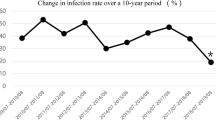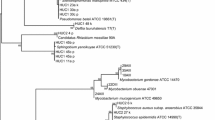Abstract
Background
The hospital bed and, especially, mattresses and pillows, which are in direct contact with patients, pose a potential risk of infection for the patient if not adequately decontaminated. The aim of this study was to examine the bacterial cultures of the mattresses in burn center and the correlation between the bacterial cultures of the burn patients and their mattresses.
Methods
Three bacterial samples from the mattresses of 11 burn patients were taken during the treatment in the burn center, resulting in 28 samples.
Results
The most common bacteria in mattress swabs were coagulase-negative staphylococci, typical skin normal bacterial flora. Pathogens problematic to burns patients (pseudomonas and acinetobacteria) transferred from the patients to mattresses. Some bacteria were found only in the mattresses.
Conclusions
Our data show that bacterial transfer from the patient to mattress is possible. We recommend that, as a part of the infection control program, burn centers should monitor the decontamination of mattresses by sampling them after disinfections.
Level of Evidence: Level IV, diagnostic study.
Similar content being viewed by others
Avoid common mistakes on your manuscript.
Introduction
Patients with major burns are, by definition, immunosuppressed, thus, there is a potential risk for acquiring a life-threatening infection [1]. Immune deficit due to the modulating effect of thermal injury includes impaired cytotoxic T lymphocyte response, impaired neutrophil function, decreased macrophage production, and neutropenia [2–4], making the burn patient especially vulnerable to infections.
Nosocomial infections are a significant problem in burn patients and bear clinical relevance. The reported incidence of nosocomial infections among burns patients varies at 63–240 per 100 patients and 53–93 per 1,000 patient days, depending mainly on the definitions used [5, 6]. Mortality due to nosocomial infections in burn patients is defined mostly by an advanced age, high percent TBSA, and having an underlying disease [7]. Besides increasing morbidity and mortality, nosocomial infections have significant economic consequences [8].
In patients with burns, infections arise from multiple sources; normal human skin is contaminated and colonized with microorganisms, and the moist, avascular burn eschar fosters microbial growth. Delays in surgical treatment have also been shown to increase invasive wound infections [7, 9].
Other sources of infections are common to other patients in intensive care units, including intravascular catheter-related infections and ventilator-associated pneumonia [10, 11], with an overall incidence of infection higher than that of other patients in intensive care units [6]. The role of the inanimate environment as a source of nosocomial infection is controversial [12]. However, there is evidence that especially burn units tend to be more contaminated than that of nonburn units [13]. The hospital bed and, particularly, mattresses and pillows, which are in direct contact with patients, pose a potential risk of infection for the patient if not adequately decontaminated [13, 14]. We sought to examine the bacterial cultures of the mattresses in burn center and the correlation between the bacterial cultures of the burn patients and their mattresses.
Patients and methods
The prospective study was conducted in the Helsinki Burn Centre, Department of Plastic Surgery, Helsinki, Finland, during 1 May 2009 to 31 January 2010. The study population consisted of adult patients with large burns requiring intensive care. Mattresses are special pressure-relieving mattresses. Samples were taken between the mattress cover and air cells. Three bacterial samples were taken during the course of treatment: the first sample before the beginning of the treatment, the second sample after 2-week treatment, and the last sample when the mattress was no longer needed, before laundry. The first sample also assessed the adequacy of cleaning methods between patients.
Results
We included 11 (nine men) burn patients, with a mean age of 51 years. Etiology of the burn injury was flame in ten patients. The total body surface area burned ranged from 8 to 70 %, summarized in Table 1.
The total number of samples was 28. In four cases, the cultivations were negative at every time point. In the first cultivation, seven were negative for bacteria.
The most common bacteria in mattress cultivations were Gram-positive bacteria, normally found on the skin Table 2. Bacillus cereus was found in two different mattresses, even though this bacterium was not found from the cultures taken from the corresponding patients.
There were individual bacterial findings such as Enterococcus faecium, Acinetobacter radioresistens, Staphylococcus haemolyticus, and Neisseria apatogenica. Of these findings, E. faecium and S. haemolyticus were also found in patients’ wound samples.
Discussion
In this study, the bacteria isolated from the mattresses of patients with burns were typical skin normal bacterial flora (coagulase-negative staphylococci and difteroids) or environmental (B. cereus) or bacteria of the GI canal (enterococci, micrococci, and Neisseria). In only 36 % of the cases the swabs from the mattresses were negative at every time point.
Our data shows that bacterial transfer from the patient to mattress is evident and in line with previous literature [14–16]. We also suppose, in the light of these present results, that translocation from the mattress to patient is possible. However, due to our study setting, two-week period between the first and second bacterial culture, it was not traceable. Further, it seems that mattresses can be carriers to other environmental bacteria. B. cereus, A. radioresistens, and N. apatogenica were found only in the mattresses.
Although infection is still the most frequent complication in thermal injuries, the number of patients dying of septicemia has decreased [1, 17]. Still, the burn wound sepsis remains an important infectious complication among burn victims. The outer surface of adult skin is colonized by a small number of microorganisms [18]. Thermal damage to the skin, resulting in the loss of the protective barrier, is an important step in the development of an infection. Nonpathogenic bacteria, belonging to normal human flora, may become pathogenic and, consequently, cause minor to life-threatening infections, especially in patients with immunosuppressed states, such as large burns [19].
Gram-negative bacteraemia, in contrast to Gram-positive bacteremia, is a significant predictor of mortality in burn patients [20]. Our results showed that Gram-negative bacteria were found growing in the mattresses, translocated from the patient’s wounds. Therefore, it is imperative that these pathogens problematic to burn patients should not be moved on to the next patient by the mattress.
Mattress contamination with various organisms, including MRSA, Pseudomonas aeruginosa, and Acinetobacter has been reported in a number of studies [14]. In the burn unit setting, wet mattresses served as an environmental reservoir of Acinetobacter [16]. Damaged mattresses have been found to be the source of contamination during outbreaks. During a pseudomonas outbreak in the burn unit, water-proof nylon-coated mattress cover was damaged by the silver nitrate solution, and pseudomonas survived in the foam under the cover [15]. It seems that mattresses are not considered as a potential source of nosocomial infections in the hospital. An audit of mattresses indicated that a large number of mattresses required replacement [21]. Cleaning and drying of the mattresses may remove organisms from the cover, while the inner wet foam may still contain bacteria that can leak out when a patient lies on the mattress [15], especially if the mattress is damaged. Perhaps, using biocidal textiles, especially in those textiles that are in close contact with the patients, might significantly reduce bioburden in clinical setting [22].
We conclude that the infection control program for burn centers requires strict compliance with a number of environmental control measures that include enforced hand washing and the use of personal protective equipment. Special pressure-relieving mattresses should be cleaned and disinfected according to manufacturer’s instructions. Damaged mattresses should be promptly replaced, and we recommend that, as a part of the infection control program, burn centers should monitor the decontamination of mattresses by sampling them after disinfections.
References
Bloemsma GC, Dokter J, Boxma H, Oen IM (2008) Mortality and causes of death in a burn centre. Burns 34(8):1103–1107
Gamelli RL, He LK, Liu LH (2000) Macrophage mediated suppression of granulocyte and macrophage growth after burn wound infection reversal by means of anti-PGE2. J Burn Care Rehabil 21(1 Pt 1):64–69
Hunt JP, Hunter CT, Brownstein MR, Giannopoulos A, Hultman CS, deSerres S, Bracey L, Frelinger J, Meyer AA (1998) The effector component of the cytotoxic T-lymphocyte response has a biphasic pattern after burn injury. J Surg Res 80(2):243–251. doi:10.1006/jsre.1998.5488
Shoup M, Weisenberger JM, Wang JL, Pyle JM, Gamelli RL, Shankar R (1998) Mechanisms of neutropenia involving myeloid maturation arrest in burn sepsis. Ann Surg 228(1):112–122
Chim H, Tan BH, Song C (2007) Five-year review of infections in a burn intensive care unit: high incidence of Acinetobacter baumannii in a tropical climate. Burns 33(8):1008–1014
Wibbenmeyer L, Danks R, Faucher L, Amelon M, Latenser B, Kealey GP, Herwaldt LA (2006) Prospective analysis of nosocomial infection rates, antibiotic use, and patterns of resistance in a burn population. J Burn Care Res 27(2):152–160
Alp E, Coruh A, Gunay GK, Yontar Y, Doganay M (2012) Risk factors for nosocomial infection and mortality in burn patients: 10 years of experience at a university hospital. J Burn Care Res 33(3):379–385. doi:10.1097/BCR.0b013e318234966c
Armour AD, Shankowsky HA, Swanson T, Lee J, Tredget EE (2007) The impact of nosocomially-acquired resistant Pseudomonas aeruginosa infection in a burn unit. J Trauma 63(1):164–171. doi:10.1097/01.ta.0000240175.18189.af
Xiao-Wu W, Herndon DN, Spies M, Sanford AP, Wolf SE (2002) Effects of delayed wound excision and grafting in severely burned children. Arch Surg 137(9):1049–1054
Cagatay AA, Ozcan PE, Gulec L, Ince N, Tugrul S, Ozsut H, Cakar N, Esen F, Eraksoy H, Calangu S (2007) Risk factors for mortality of nosocomial bacteraemia in intensive care units. Med Princ Pract 16(3):187–192
Santucci SG, Gobara S, Santos CR, Fontana C, Levin AS (2003) Infections in a burn intensive care unit: experience of seven years. J Hosp Infect 53(1):6–13. doi:S019567010291340X
Hota B (2004) Contamination, disinfection, and cross-colonization: are hospital surfaces reservoirs for nosocomial infection? Clin Infect Dis 39(8):1182–1189. doi:10.1086/424667
Boyce JM, Potter-Bynoe G, Chenevert C, King T (1997) Environmental contamination due to methicillin-resistant Staphylococcus aureus: possible infection control implications. Infect Control Hosp Epidemiol 18(9):622–627
Creamer E, Humphreys H (2008) The contribution of beds to healthcare-associated infection: the importance of adequate decontamination. J Hosp Infect 69(1):8–23. doi:10.1016/j.jhin.2008.01.014
Fujita K, Lilly HA, Kidson A, Ayliffe GA (1981) Gentamicin-resistant Pseudomonas aeruginosa infection from mattresses in a burns unit. Br Med J (Clin Res Ed) 283(6285):219–220
Sherertz RJ, Sullivan ML (1985) An outbreak of infections with Acinetobacter calcoaceticus in burn patients: contamination of patients’ mattresses. J Infect Dis 151(2):252–258
Kallinen O, Maisniemi K, Bohling T, Tukiainen E, Koljonen V (2012) Multiple organ failure as a cause of death in patients with severe burns. J Burn Care Res 33(2):206–211. doi:10.1097/BCR.0b013e3182331e73
Mackowiak PA (1982) The normal microbial flora. N Engl J Med 307(2):83–93. doi:10.1056/NEJM198207083070203
Church D, Elsayed S, Reid O, Winston B, Lindsay R (2006) Burn wound infections. Clin Microbiol Rev 19(2):403–434. doi:10.1128/CMR.19.2.403-434.2006
Mason AD Jr, McManus AT, Pruitt BA Jr (1986) Association of burn mortality and bacteremia. A 25-year review. Arch Surg 121(9):1027–1031
Peto R, Calrow A (1996) An audit of mattresses in one teaching hospital. Prof Nurse 11(9):623–624, 626
Borkow G, Gabbay J (2008) Biocidal textiles can help fight nosocomial infections. Med Hypotheses 70(5):990–994
Acknowledgments
Support was provided solely from departmental sources.
Conflict of Interest
None.
Author information
Authors and Affiliations
Corresponding author
Rights and permissions
About this article
Cite this article
Koljonen, V., Sikkilä, L., Laitila, M. et al. Bacterial cultures in burn patients’ mattresses. Eur J Plast Surg 35, 813–816 (2012). https://doi.org/10.1007/s00238-012-0749-4
Received:
Accepted:
Published:
Issue Date:
DOI: https://doi.org/10.1007/s00238-012-0749-4




